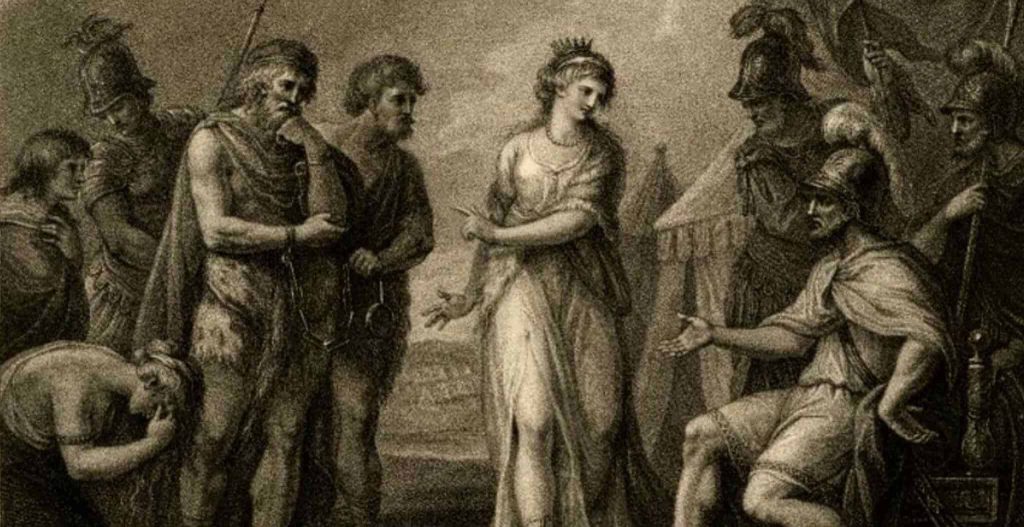Cartimandua, reigned as the queen of the Brigantes during the 1st century. The Brigantes were a significant tribe located in the northern regions of Britain. She maintained her authority through backing received from the invading Roman armies. She was one of only two British women to be mentioned in Tacitus, The Annals of Imperial Rome, the other being Boudicca, mentioned by Dio.
Cartimandua’s Early Life
Details about Cartimandua’s early life and her ascent to the queenship of the Brigantes remain undocumented. At the time of the invasion, the British Isles were inhabited by independent tribal groups, each with a distinct culture and varying policies towards Rome.
Queen Cartimandua, a member of a powerful family [Also translated as “virtue of her illustrious birth”], who ruled the Brigantes.
Gaius Cornelius Tacitus’ The Histories, Book 3, 45
Cartimandua was the leading noble of the Brigantes who was probably granted a client ship with Rome in 43AD, along with her consort Venutius of the Carvetii.
First Brigante Rebellion (48AD)
During the spring of 48AD, political pressure from certain rebels within the Brigantian nobility forced Publius Ostorius Scapula to abandon his campaign against the Ordovices in north Wales, and turn his attention to the Brigantes, presumably this was to support Cartimandua and and help her retain power.
And now Ostorius had advanced within a little distance of the sea, facing the island Hibernia, when feuds broke out among the Brigantes and compelled the general’s return, for it was his fixed purpose not to undertake any fresh enterprise till he had consolidated his previous successes. The Brigantes indeed, when a few who were beginning hostilities had been slain and the rest pardoned, settled down quietly…
Tacitus, The Annals of Imperial Rome – Book 12, XXXII
Cartimandua Captures Caratacus (51AD)

In 51AD Cartimandua tricked and captured the Catuvellaunian warlord Caratacus, then honoured her agreement with Rome by surrendering him to Scapula, who was still governor (Tacitus Annals XII, 36).
There is seldom safety for the unfortunate, and Caractacus, seeking the protection of Cartimandua, queen of the Brigantes, was put in chains and delivered up to the conquerors, nine years after the beginning of the war in Britain.
Tacitus, The Annals of Imperial Rome – Book 12, XXXVI
This action seems to have stirred up some resentment towards the rule of Cartimandua within the Brigantian nobility, which for a period, lurked beneath the surface of the seemingly calm tribal pool.
Cartimandua Divorces Venutius (51 to 57 AD)
After Caratacus’ capture, we don’t know the precise date, but sometime between 51 and 57 AD ,Cartimandua divorces her husband, Venutius and begins a relationship with his shield bearer Vellocatus.
She threw over Venutius, who was her husband, and gave her hand and kingdom to his armour bearer, Vellocatus. This crime soon proved the ruin of her house. The people supported her husband: she defended her lover with passionate ferocity.
Gaius Cornelius Tacitus’ The Histories, Book 3, 45
Venutius Wars against Cartimandua (52 to 57 AD)
Venutius retreated to his powerbase amongst the Carvetian tribes people, and became increasingly hostile to Cartimandua. Cartimandua showed cunning by taking Venutius’ brother and other relatives hostage, although Venutius led a daring raid and freed them.
At first, however, they simply fought against each other, and Cartismandua by cunning stratagems captured the brothers and kinsfolk of Venutius. This enraged the enemy, who were stung with shame at the prospect of falling under the dominion of a woman. The flower of their youth, picked out for war, invaded her kingdom.
Cornelius Tacitus – The Annals, Book 12, Chapter 40
The Romans defended their client queen and Venutius’s revolt was defeated by Caesius Nasica during the governorship of Aulus Didius Gallus (52 – 57 AD).
Tacitus mentions the event in The Annals and states that Cartimandua retained her throne.
[S]ome cohorts were sent to her aid and a sharp contest followed, which was at first doubtful but had a satisfactory termination. The legion under the command of Caesius Nasica fought with a similar result. For Didius, burdened with years and covered with honours, was content with acting through his officers and merely holding back the enemy. These transactions, though occurring under two propraetors, and occupying several years, I have closely connected, lest, if related separately, they might be less easily remembered. I now return to the chronological order.
Tacitus, The Annals of Imperial Rome
Cartimandua retains her Throne
Cartimandua continued to rule the Brigantes for a number of years with her own armour-bearer, Vellocatus, as her consort.
In 60AD, led by Boudica, the Iceni tribe rose in rebellion against the Romans. However, Cartimandua remained faithful to the Roman alliance, refraining from participating in the revolt or encouraging her tribe to back it.
Venutius Leads another uprising (70 AD)
However, the seeds of discontent were still germinating in the ranks of the Brigantian ruling houses for another rebellion occurred during the governorship of Marcus Vettius Bolanus around 70AD.
During this uprising, Cartimandua had to be rescued by an ala of Roman auxiliary cavalry sent specifically for this purpose by the governor who was occupied against the Silures in south Wales. This continuing Brigantian unrest caused the emperor Vespasian to annul the clientship of the Brigantes and for the first time, they came under the direct rule of Rome.
She petitioned for troops from Rome. Our auxiliaries, both horse and foot, then fought several engagements with varying success, but eventually rescued the queen. Thus the kingdom was left in the hands of Venutius and the war in ours.
Cornelius Tacitus: The Histories, Book Three: XLV
Following these events, Cartimandua disappears from the sources.